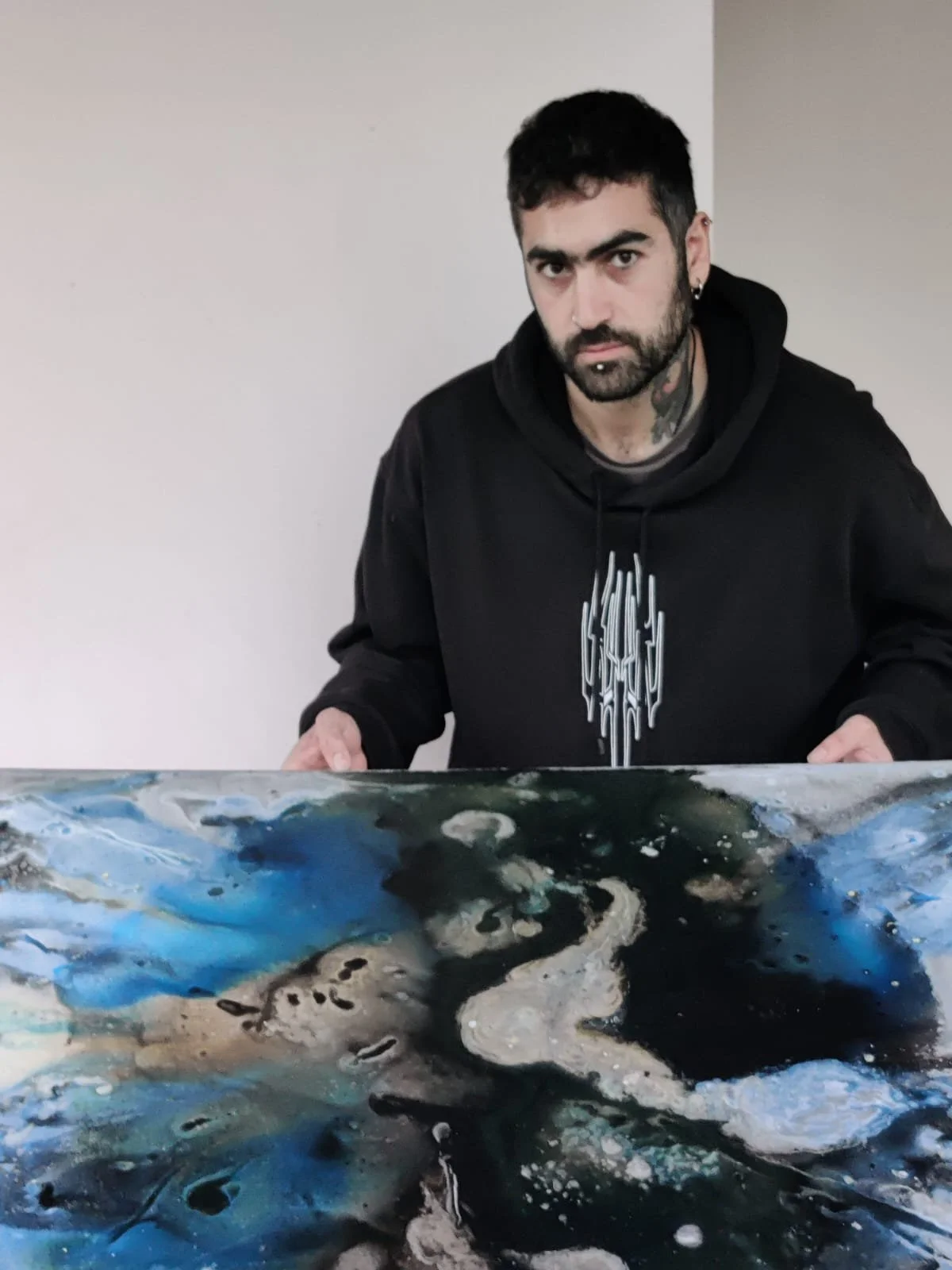10 Questions with Anne-Marie Chikhany
Anne-Marie Chikhany - Portrait
Anne-Marie Chikhany (2000) is a Lebanese artist and iconographer whose work spans a wide range of artistic styles. From a young age, she showed a deep passion for painting and drawing, which led her to pursue a career in the arts. She studied graphic design before specializing in Restoration et Art Sacré at USEK, where she refined her skills in sacred art and traditional techniques.
As an iconographer, Anne-Marie follows the authentic Byzantine tradition, using natural pigments, egg tempera, and gold leaf to create meticulously detailed and spiritually profound icons.
Beyond sacred art, she explores contemporary and Abstract painting, using colour as a central element to evoke emotions and invite introspection. Her artistic philosophy is rooted in the belief that art is a bridge between emotions and the viewer, creating a space for personal reflection.
Throughout her career, she has participated in a variety of exhibitions. She continues to evolve as an artist, blending tradition with modern expression and inspiring others through her teaching and creative journey.
ARTIST STATEMENT
She explores the depths of human emotion through her work, using colour, form, and texture as a means of expression. Her art serves as a bridge between feeling and reflection, inviting viewers into a world of introspection.
Her abstract paintings are deeply rooted in emotion, where colours play a crucial role in translating feelings onto the canvas. Each piece is an exploration of energy, movement, and personal expression, allowing the viewer to find their own meaning within the layers of paint.
As an iconographer, she remains faithful to the Byzantine tradition, using natural pigments, egg tempera, and gold leaf to create sacred imagery. Every icon is a meticulous process of devotion, preserving an ancient art form.
Through her art, she seeks to merge tradition with contemporary expression, creating a dialogue between the past and the present, the seen and the felt.
Dancing Clouds © Anne-Marie Chikhany
INTERVIEW
Let’s start from the basics. What first drew you to painting and the arts? Was there a specific moment when you knew this was your path?
I’ve been drawn to painting and art since childhood. I always felt a deep connection to colours, shapes, and the way art could express emotions beyond words. I think the moment I truly knew this was my path was when I realized how art could evoke emotions. That’s when I knew art wasn’t just a passion but a lifelong path. Over time, this passion led me to study graphic design and then dive deeper into iconography and painting. Each brushstroke feels like a dialogue, emotions and expressing the unseen; that’s what keeps me dedicated to this journey.
How does your background in graphic design influence the way you approach composition and form in your work?
My background in graphic design gave me a strong foundation in composition, balance, and visual harmony skills that naturally carried over into my painting. It trained my eye to see structure, to understand how colours interact, and to create a sense of movement and rhythm in my work. Whether I’m working on an abstract piece, I approach each composition with the same awareness of space and form, ensuring that every element has purpose and impact and creates a sense of movement and emotional depth. My design background also taught me to think about the viewer’s experience, which influences the use of colour and contrast to evoke emotions and guide the eye through the artwork.
Coincidence © Anne-Marie Chikhany
You work across both sacred and contemporary art. How do these two approaches influence each other in your practice?
For me, sacred and contemporary art are two different languages that ultimately serve the same purpose, expression and connection. Iconography is deeply rooted in tradition, symbolism, and spiritual discipline, while contemporary art allows me more freedom to explore emotions and abstract ideas.
The structure and precision of iconography have taught me patience, attention to detail, and the power of symbolism. On the other hand, my contemporary paintings allow me to explore colours, textures, and emotions more freely, which in turn brings a renewed sense of creativity and personal expression. Working between these two worlds keeps my artistic journey dynamic, allowing me to balance discipline with intuition and tradition.
Your work blends tradition with modern expression. How do you navigate the balance between historical techniques and contemporary artistic freedom?
Balancing historical techniques with contemporary artistic freedom is a constant dialogue in my work. When I write icons, I adhere to traditions while writing the icons using natural pigments, egg tempera, and gold leaf. Each colour has a symbolism.
At the same time, contemporary art allows me to break free from those constraints and explore emotion, abstraction, and personal storytelling. But rather than seeing these as separate worlds, I find that they feed into each other. The precision and symbolism of iconography have sharpened my eye for composition and meaning, while the expressive nature of contemporary painting has brought new depth and movement.
For me, it’s not about choosing between them; it’s about finding harmony between them. Tradition gives my work depth and grounding, while contemporary expression allows me to bring a fresh, personal perspective.
Going into Deep © Anne-Marie Chikhany
Confusion Painting Clouds © Anne-Marie Chikhany
As an iconographer, you follow the Byzantine tradition. What does this process mean to you, both technically and spiritually?
As an iconographer, following the Byzantine tradition is both a technical and spiritual journey. Technically, the process is highly meticulous. Each layer of paint, the application of gold leaf, is done with care and precision, following the ancient method.
The use of egg tempera, for example, requires patience, as the paint must be built up in layers. The discipline involved in the technical process is key, as every detail serves a purpose, both in form and in meaning.
Spiritually, the process of creating an icon is a form of prayer and devotion. It is a way of connecting to something greater than myself. As I work, I constantly find myself in dialogue with the sacred, whether it’s contemplating the figures I paint or reflecting on the symbolism embedded in each gesture, colour, and detail. Each brushstroke is not just an artistic choice; it’s an offering, a way of channelling divine presence through the work.
This practice allows me to experience a deep sense of reverence and humility. The Byzantine tradition, with its focus on symbolism and spiritual truth, has taught me to approach each piece as more than just a painting, but as a means to communicate the sacred. It’s a process of spiritual alignment and connection, and that’s what makes iconography so meaningful to me both technically and prayerful.
Colour plays a central role in your abstract paintings. How do you choose your colour palettes, and what emotions do you aim to convey?
Colour is the soul of my abstract work. It’s the primary way I communicate emotions and feelings that words cannot express. I choose my palettes based on the emotions I want to evoke in a piece. Sometimes, I start with a particular emotion or feeling, and the colours come naturally from the mood I’m experiencing during the creation process.
The process of selecting colours is like a conversation between my inner world and the canvas. I allow the colors to interact and create harmony, movement, depending on the emotions I want to communicate. I aim for the viewer to feel something when they look at my work, whether it’s calm, excitement, or contemplation. Color becomes a tool for creating an emotional landscape something that speaks directly to the heart, creating a connection between the viewer and the artwork.
Evasion © Anne-Marie Chikhany
What do you hope people take away from experiencing your work?
I want people to feel something personal when they experience my work whether it’s a memory, an emotion, or a sense of wonder. My art is not just about aesthetics; it’s about creating a space for reflection and connection. Each piece carries its own story, but I love that viewers can find their own meanings within it. I love when people tell me they see something different each time they look at my work it means the piece is alive in their eyes.
With my icons, I hope to bring a sense of peace and spirituality. Whether through sacred art or contemporary paintings, I hope my work leaves people with a sense of beauty, depth, and inspiration.
Do you find differences in the way audiences engage with your iconography versus your abstract paintings?
Yes, there are significant differences in how audiences engage with my iconography compared to my abstract paintings.
Iconography often draws a spiritual and contemplative audience. People approach icons with reverence, seeing them as sacred objects that invite prayer and reflection.
In contrast, my abstract paintings allow for a more open and personal interaction. Since abstraction doesn’t dictate a single interpretation, viewers engage with the work based on their emotions, experiences, and imagination. Some feel a deep emotional pull from the colours and movement.
Both forms of art create meaningful engagement, but the interaction differs icons guide the viewer toward a spiritual experience, while abstract art encourages a more fluid and personal exploration. I love how each piece creates a unique dialogue with the audience.
Deep Reflections © Anne-Marie Chikhany
Teaching can be a creative act in itself. How does sharing your knowledge with others shape your own artistic journey?
Teaching is an integral part of my artistic journey because it keeps me engaged, curious, and constantly evolving. When I share my knowledge with students, I’m not just teaching them, I’m also rediscovering art through their eyes. Their perspectives, questions, and creativity often challenge me to think differently and explore new approaches in my ownwork. Teaching also requires patience and adaptability, which translates into my own practice.
While I guide my students, they also inspire me with their enthusiasm and unique ways of expressing themselves. This dialogue between teaching and creating keeps my artistic journey dynamic and full of discovery.
Lastly, what upcoming projects or themes are you currently exploring in your work?
I’m currently exploring new artistic projects that push the boundaries of emotion and expression. I’m experimenting with different themes, from abstract compositions that evoke deep feelings. My focus is on creating pieces that invite reflection and connection, blending techniques. I’m also looking forward to expanding my exhibitions on a global scale, showcasing my work in different countries and sharing my artistic vision with a wider audience.
Artist’s Talk
Al-Tiba9 Interviews is a promotional platform for artists to articulate their vision and engage them with our diverse readership through a published art dialogue. The artists are interviewed by Mohamed Benhadj, the founder & curator of Al-Tiba9, to highlight their artistic careers and introduce them to the international contemporary art scene across our vast network of museums, galleries, art professionals, art dealers, collectors, and art lovers across the globe.





















